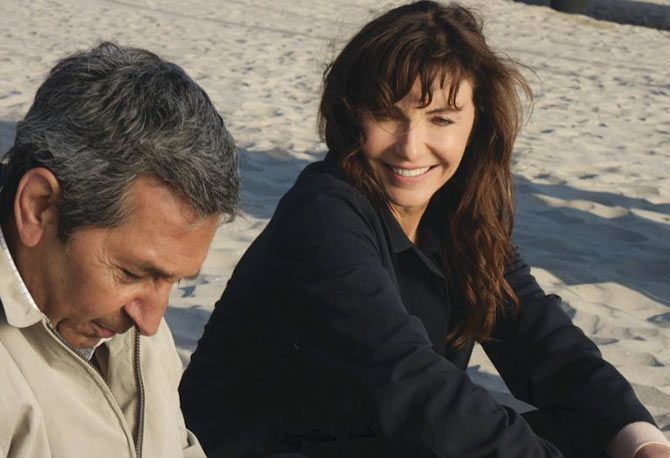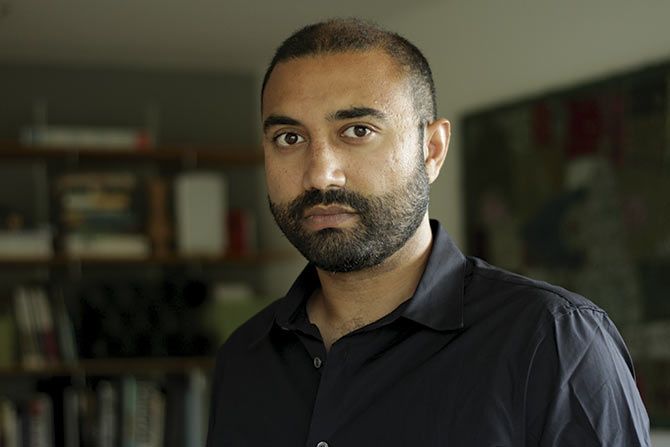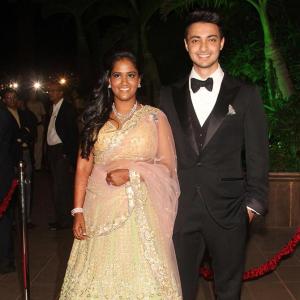Indian actors from different generations and worlds, Roshan Seth and Sendhil Ramamurthy, star in a remarkable film, co-starring Oscar winner Mary Steenburgen and Oscar nominee Michael Lerner.
Brahmin Bulls director Mahesh Pailoor, in a fascinating conversation with Arthur J Pais/Rediff.com
When Ashok Sharma (Roshan Seth), a scientist from Boston makes a surprise trip to Los Angeles to visit his estranged son, the two begin a journey to mend their relationship.
Until the son, Sid (Sendhil Ramamurthy), discovers that his father has come in search of an old love.
A 30-something disillusioned architect struggling to save his failing marriage, Sid has no patience for more conflict and emotional drama.
Then suddenly, while working in the garden, Ashok suffers a heart attack. As Sid rushes him to the hospital, Ashok asks Sid to 'Bring her... Bring Helen.'
Will Sid, who has lost his mother to cancer, come to terms with his father's past with another woman?
Brahmin Bulls, a heartfelt and often humorous family saga, is directed by Mahesh Pailoor, an alumnus of New York University's Tisch School of the Arts, and the American Film Institute who has also produced and directed award-winning commercials and branded content under his production company Nuclear Tribe.
He wrote it with his wife Anu Pradhan, an AFI alumna and a Fulbright Scholar, whose Sloan Award-winning short film Dharini was selected by AFI to represent its Conservatory at the Cannes Film Festival.

You could have made a film with a mainstream subject. Why did you choose this story?
We wanted to create a universal story that starred Indian actors, but didn't have a central conflict dealing with cultural identity.
Being second generation Indian Americans, both my wife Anu and I wanted to portray Indian-American characters and situations, without relying on stereotypes...
We didn't want to sanitize the relationship between the father and son. All relationships are complex. Nothing is ever black and white.
It was important to us that we deal with things in a real way. In our case, both the father and son are dealing with issues of infidelity, loss, and ultimately regret.
Growing up in the US in the 1990s and watching mostly American films, there were very few South Asian characters represented on screen. It wasn't until I started watching films from Mira Nair and Gurinder Chadha that I started to see characters that I could really relate to.
So, when it came time to make my first feature film, I wanted to tell a story with characters that were reflections of me and the people that I know. Although not a mandate, this was important to me.
We hope that Brahmin Bulls becomes part of a larger conversation about diverse leading characters.
If cinema is a reflection of a society, than we have to move towards a more multi-cultural makeup in our movies.
Although not autobiographical, this film drew a lot of inspiration from my relationship with my father. As in the film, my father (a businessman in a small Maine town) has shown up at my doorstep in Los Angeles without telling me. A lot of his anecdotes and stories he used to tell me also ended up in the film.
For instance, Ashok talks about wanting to come to the US to win a Nobel Prize. That was the same story and ambition that lead my father to the States.
Now, in my 30s, I have a different relationship with my father. I see him more as an individual and wonder what his life was like when he was my age.
Part of the impetus for making Brahmin Bulls was to answer the question, what if I could have a conversation with my father when he was my age.
What would he be like? What would his hopes and dreams be? And ultimately, would we like each other? Would we get along?
Part of what Sid and Ashok find in the movie is that they are a lot more alike than they would have thought.
I also began realising that how as children we grow up thinking that our parents are infallible, that they are the perfect models for us.
But as we got older and had a family, there was this realization that the parents are only human; that they were once just like us, young, hopeful, naive, and completely capable of messing up their lives and those of the children.
But Brahmin Bulls is not just about conflict. In the final reckoning, it is a story about that reconciliation. It is a story about an adult father and adult son learning the truth about each other for the first time.
It is a story about family bonds and what it takes to both break them and mend them.
I had been working on a story about a father and son learning about each other for the first time as adults for many years. But it wasn't until Anu brought the idea of a woman from the past coming back into the father's life that the story did the project took a definite shape.

How autobiographical is this film?
But it cannot be said to be uniquely Indian.
That was our goal: To tell an American story that had a multicultural cast. Although the lead characters are Indian American we wanted to tell a universal story that would appeal to a broad audience.
Their Indian heritage adds a specificity to their respective characters, but it doesn't define their central conflict.
One of the main questions that people have about the film before watching it is: Is it an Indian film? I think the answer to that is more a reflection of where we are currently as South Asians in America.
Being second generation and growing up in the 90s, there used to be more weight given to the question of identity. Are you Indian or are you American? The quintessential ABCD.
But I think, as a group, we've now moved well beyond that notion. South Asians are more ingrained in American society. We've become governors, CEOs, actors on television shows, and even a surgeon general.
So, now I think, as a group, we've been able to take more ownership of our identity.
We are Indian AND American at the same time.
In a lot of ways, that's what Brahmin Bulls represents. So is it an Indian film? Yes, but it's also very much an American film.
As we've been screening at film festivals around the world, one of the interesting experiences has been finding out who our audience is. At its core, we've been playing to a lot of South Asian audiences at South Asian festivals. But we've also played at festivals that cater to a broader audience.
In Sonoma, California for example, we played to sold out crowds that were predominantly older and Caucasian. We even won the main Jury Award!

How did you get the cast?
I have known Sendhil Ramamurthy when we were both starting out in New York. Sendhil had acted in one of my NYU films called Little India. I could not have asked for a better actor to be in that film. Brahmin Bulls was written with Sendhil in mind.
Roshan Seth, meanwhile, lives in Delhi, India and took some convincing... At 74, he was a bit apprehensive of flying to the US to do an independent film, but after reading the script and meeting me, he felt comfortable. He told me later that he felt he was going to be in good hands.
The rest of the cast, including (Oscar winner) Mary Steenburgen, (Oscar nominated) Michael Lerner, Cassidy Freeman, Monica Raymund, and George Newburn, all came through our amazing casting directors, Danielle Aufiero and Amber Herd. The actors responded to the script.
How was it to be a first time director?
Both the writing and directing part took much effort. We had written a script which had a tennis match between the father and son. Sendhil is a once nationally ranked player. Every tennis ball that he hits in the film is real.
The script was actually written for Sendhil and tennis was always part of the story, knowing full well that Sendhil would be able to play.
Roshan Seth, on the other hand, has never played tennis. An original scene of Ashok playing a match with Sid had to be changed to Ashok coaching Sid, in order to convince Roshan that he could play the part. This took quite some time, the reworking of the script.
As in any independent film, we had the same road blocks that everyone goes through -- budget, time, and even less budget and time. But we had an amazing and dedicated cast and crew, so there were very few hiccups during the production and post.
Making independent films is really a labour of love, so I brought on board a lot of people that I had worked with in the past. We really strove to make a film that looked and felt bigger than our budget.
One of the biggest challenges of making an independent film is the lack of time. We had 20 days to shoot and numerous locations all over the city. Every day we would be on the move, shooting scenes completely out of order and cutting scenes in order to make our days.
When that happens, it's extremely important that you remain calm and present with what's happening around you, while also maintaining a grasp on the overall story.
One of my favorite scenes in the film is towards the end when Ashok and Sid are saying goodbye. It was never in the script, and therefore never on the schedule. But I felt like a beat was missing between the two of them.
So towards the end of our shoot, just as we were finishing another scene, I pulled our producer aside and told him I thought we needed to add a scene. Within minutes we were blocking and setting up the shot, racing to get it before the sun went down.
Everyone worked to make it happen. I realized in that moment how important it is to trust your instincts and to react to what's around you.

You were a first-time feature director working with a very experienced cast that has worked under directors ranging from the Coen Brothers to Steven Spielberg. What did you as a director take from your principal cast?
I learned so many different things from each person. One of the biggest lessons is that every actor is different, and that a large part of directing is being able to listen and adjust to each actor's needs.
Where one actor likes to rehearse and go over lines, another actor might only want to say lines in front of the camera.
There is one really nice story about Roshan and Michael Lerner. Just before Roshan was about to come to the US, he had asked us if we could help him with a few things. The first, he wanted us to get him a meeting with Spielberg (Roshan had acted in Temple Of Doom).
The second request was that we reach out to an old friend of his whom he hadn't seen since they were in drama school together in London more than 40 years prior. That person was Michael Lerner.
Little did Roshan know that we were already casting him for the part of David, Ashok's best friend in the movie. Their onscreen chemistry is real.









